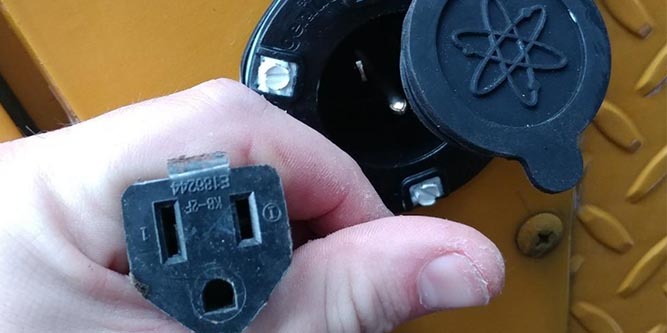When you have an RV, camper van, or boat, you sometimes need to plug into shore power. Yes, “shore power” started as a maritime term. But now, it applies to any kind of larger vehicle with on-board batteries that need to be charged. Sometimes, you can meet all your power needs with your alternator and a power inverter. But when you’re docked, or when your RV is parked at a campground, that’s not practical. You don’t want to have your engine idling the entire time, and if you do, your neighbors will complain. Instead, you want to plug your vehicle into an electrical power supply. That’s where shore power comes in.
Most large boats and RVs come already equipped to plug into shore power. After all, it’s understood that you’re going to need to use it. That said, a lot of smaller boats may not come outfitted. If you’re building a camper van, you’re certainly not going to have a pre-existing power port. In those cases, you’ll have to install your own. But you may also need to install a power inlet port on a vehicle that already has one. For example, different countries have different power standards. Even here in the US, you might encounter 15-, 30-, or 50-amp RV power hookups. If you’re going to be using 15-amp power a lot, it makes sense to have the correct inlet port.
We’re about to review three of the best 15-amp AC power inlet port charger plugs on the market. We’ll start with the NOCO GCP1 15 Amp AC Port Plug. This is a robust power inlet port with a low-profile design. Next, we’ll check out the Journeyman-Pro 15 Amp AC Power Inlet. This is a slim power inlet port that only requires a 1 ¾-inch hole. Third, we’ll examine the WELLUCK 15 Amp 125V AC Power Inlet. This is an exceptionally durable inlet port with UV-resistant plastic and corrosion-resistant prongs. But which one is the best-suited for your vehicle? To find out, we’ll have to dig a little deeper into all of our options. Let’s get started, and see what we learn!
Shore Power Basics
Let’s back up a second. How does shore power work to begin with? In a nutshell, you plug your vehicle into a fixed power supply. From there, it depends on your power setup. You might want to operate AC appliances, or simply to charge 12-volt deep cycle batteries. Or, you might be doing a combination of the two. Regardless, there’s a three-prong plug on the outside of your vehicle, and you connect that to a power outlet.
This might sound pretty straightforward. And when you have the right kind of charger plug, it is. But there are numerous electrical standards, and you need to have the correct one for the job. Think about the breaker box on your house. If you try to draw too much power from a single circuit, the breaker will trip. This prevents you from overloading your home’s wires and starting a fire.
The same principle applies to the plug at a campground. If you try to draw too much power, you’ll trip the campground’s breaker. Otherwise, you could damage their wiring. Along the same lines, if you plug into a supply that’s too powerful, you could damage your vehicle’s wiring. If you’re plugging in appliances, you can even damage those appliances. That’s why it’s so important to have the right kind of power inlet port. It needs to be the correct voltage and amperage for both your vehicle’s power system and the campground’s.
Shore Power Installation
So, how do you choose the right voltage and amperage? The voltage part is easy, because it depends on where you live. If you’re in North America, standard voltage is between 110 and 130 volts. If you’re in Australia, the UK, or most of Europe, the standard voltage is between 220 and 240 volts. Unless you’ve bought your RV or boat from overseas, it will already have the correct type of wiring. But if you’re outfitting a vehicle for the first time, make sure to choose the correct voltage. It’s also important to choose compatible appliances. In a North American-wired vehicle, all appliances should run on 110-130 volts. In other vehicles, they should all be 220-240 volts.
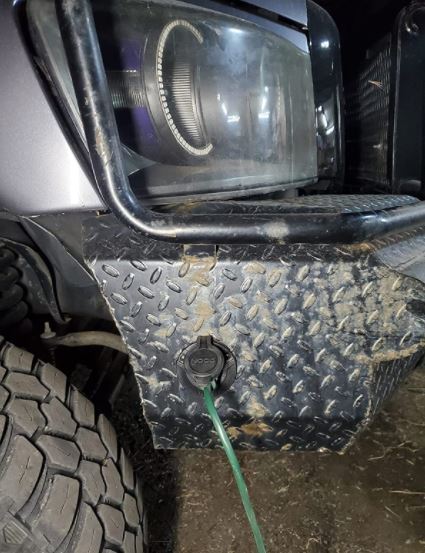
Amperage is a little bit more complicated. Because of their lower voltage, North American power supplies tend to have higher amperage. The three standards are 15-, 30-, and 50-amps, and they each have a distinct plug. Some campgrounds give you multiple power options, which can be nice if you have multiple inputs. 15-amp power is generally the most cost-effective, so it’s a popular choice for people adding a new port. All three of today’s AC power inlet port charger plugs are 15-amp North American-style cords.
For international users, amperage is more variable, but tends to be lower due to the higher voltage. The UK standard is anywhere from 10 to 16 amps. In continental Europe, you see an even wider range. There, you can see amperages as high as 20 amps, or as low as 5 amps.
In order to connect your vehicle to the power supply, you’re going to need an extension cord. The goal here, as with any extension cord, should be to use something more powerful than you need. And the longer the cord is, the thicker it should be. That’s because longer cords provide more resistance, which creates heat. A fatter wire has more capacity to begin with, so heat isn’t as much of a concern. For a run of less than 20 feet and North American 15-amp power, a 14-gauge wire is sufficient. If you’re going to reach further than that, you’ll want to use a fatter, 12-gauge wire.
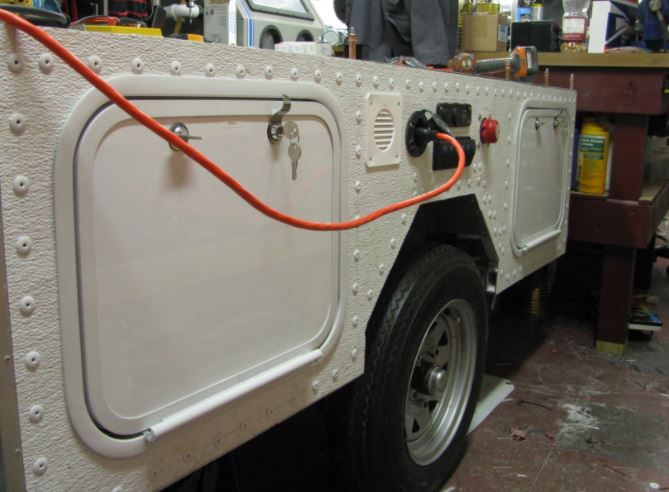
Higher amperages will use larger cables. 30-amp cables will have their own special prongs that don’t plug into 15-amp outlets. A 50-amp cable will have a twist-lock plug that once again won’t be compatible with the others. 50-amp power supplies also require a 4-core cable, which means there are actually two separate circuits. This allows for more power delivery than you can get from a single circuit alone. That said, you’re looking at a heavier, bulkier, more expensive cable.
No matter how well-equipped your RV, boat, or van is, you might run into situations where there’s no compatible power. Maybe you pull up to a campsite, and all they have is a 30-amp supply. If you only have a 15-amp or 50-amp power input, you won’t be able to plug in. That’s why it can be helpful to carry some adapters. If you’re in the US and you have a 15-amp input, it’s wise to travel with 30- and 50-amp adapters. This is even more true for road-tripping Europeans. There, you may require multiple adapters in order to plug into multiple local standards.
Things are also more complicated for US boaters. Prior to the passage of the National Electric Code in 1978, there were many marine power standards. If you’re mooring at a newer marina, you won’t have to worry about this. But there are plenty of marinas that predate the passage of the Code. In that case, you could be dealing with any number of power situations. When you’re traveling to an unfamiliar marina, it’s always smart to call ahead and ask about shore power. If they use a non-standard connection, you’ll be able to obtain an adapter ahead of time.
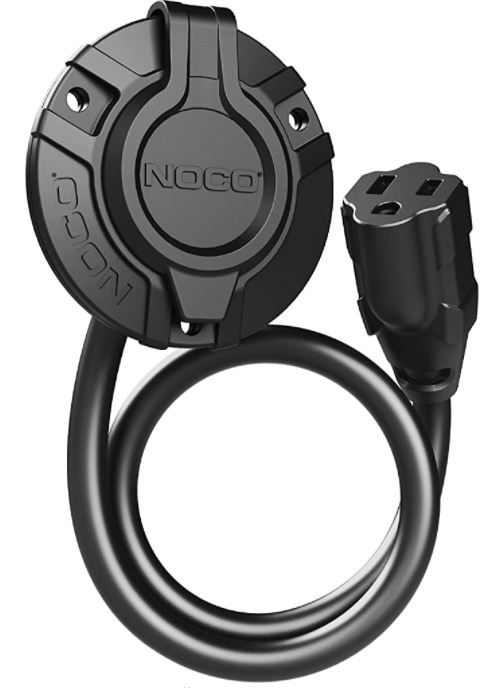
NOCO GCP1 15 Amp AC Port Plug
The NOCO GCP1 15 Amp AC Port Plug has a highly water-resistant design that’s great for boats. The outer portion consists of a three-prong plug, inside a recessed black circular fitting. This fitting is constructed from a soft plastic, with a wide flange that covers the installation hole. There’s a watertight cap, which attaches to a little ring gasket that installs behind the flange. This keeps the cap conveniently secured, and also provides an added measure of waterproofing.
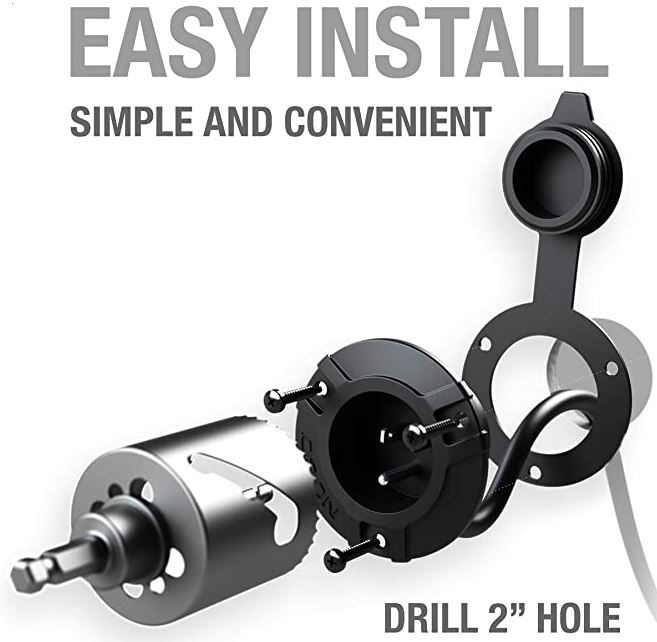
Installation is a bit of a mixed bag. On the one hand, it installs via a standard 2-inch hole, and it’s very low profile. At only 1.8 inches thick, it’s great for narrow walls or hulls without a lot of interstitial space. That said, the extension cord comes out from the back at an angle. It’s a nice enough cord, with a length of 16 inches and durable insulation. But if you’re in a thicker wall, the angle makes it impossible to install in a simple 2-inch hole. Instead, you’ll have to carve out a larger opening on the inside, to make room for the cord. Another thing to keep in mind is that the 3-screw installation is great for attaching to wood or other solid material. But if you’re going into a studded trailer wall, you’ll only be able to hit one stud. The other two screws will just be in the aluminum, which makes them vulnerable to getting pulled out.
In terms of power rating, this port plug is all you’ll need for simple three-prong power. It’s rated for 15 amps and 125 watts, with 14-gauge copper wire. As long as that’s what you’re plugging into, you won’t have any safety issues.
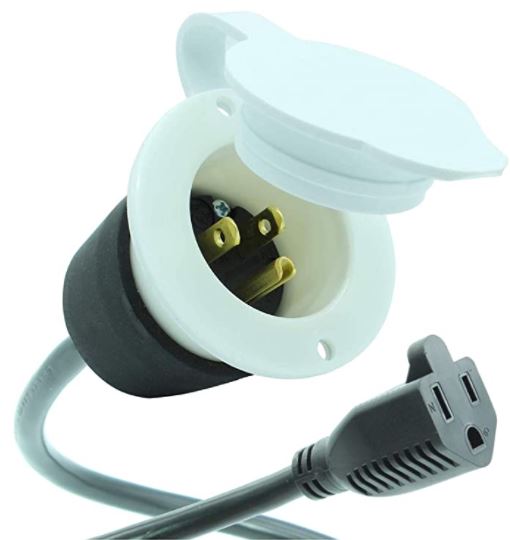
Journeyman-Pro 15 Amp AC Power Inlet
The Journeyman-Pro 15 Amp AC Power Inlet comes in white or black, to match more vehicles. It’s also not branded, so it will blend in with your other electrical components. The visible, outside portion consists of three prongs inside a round flange. The flange also has a waterproof cap attached to keep your prongs dry.
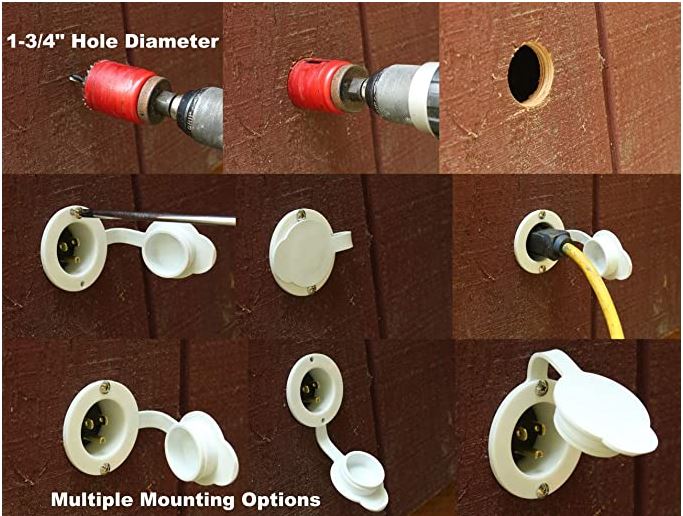
This is a compact power inlet, and it’s designed to install in an undersized 1 ¾-inch hole. Installation is fairly straightforward, with two long screws. It’s great for screwing into plywood sheathing, or for just about any other type of material. It’s not as low-profile as the NOCO plug, but the pigtail comes straight out the back. This means you only have to drill out a straight hole. However, because of the design, you have to partially disassemble the plug during installation. You need to take off the back cover and the pigtail, then reattach them after the plug is installed.
The pigtail itself has a length of 20 inches. Like the NOCO plug, it’s rated at 15 amps, and contains 14-gauge copper wire.
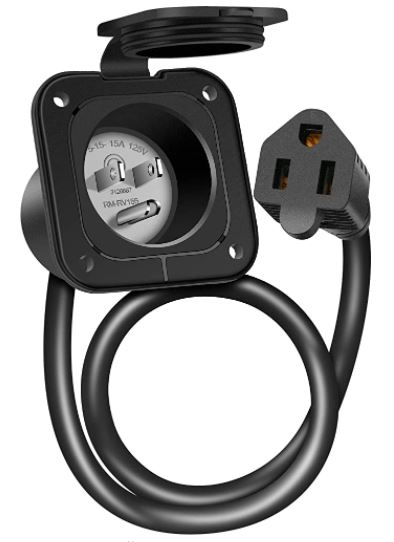
WELLUCK 15 Amp 125V AC Power Inlet
The WELLUCK 15 Amp 125V AC Power Inlet has a square black outer flange, with holes at the 4 corners. This gives it a larger profile than the last two, but it can actually be easier to install. Because the flange is so wide, you can attach 2 screws on one side directly into a stud. That’s great for installing in just about any vehicle with studs or ribs in the sides. It goes into a standard 2-inch hole, so you won’t have to modify pre-drilled vehicles.

As far as safety goes, you get a lot of the same features. There’s an 18-inch pigtail, with 14 gauge copper wire and a 15-amp rating. However, all of the plastic is UV-resistant, so it won’t get cracked from extended sunlight. The prongs are also nickel-coated, which makes them more resistant to corrosion.
Final Verdict
So, which one of these 15-amp AC power inlet port charger plugs is the best choice for your vehicle? Let’s go over what we’ve learned. The NOCO GCP1 15 Amp AC Port Plug is probably the best choice for boats. It has the rubber gasket for added water-resistance, and its low profile makes it suitable to install on a hull. That said, it’s less well-suited for thicker walls, and the screw configuration makes it unsuitable for vans or trailers.
The Journeyman-Pro 15 Amp AC Power Inlet is a solid choice when hole size is an issue. Granted, it’s only ¼-inch smaller than our other options. But that can make a difference if you’re in a tight space. The 2-screw installation is also secure, but installation requires you to disassemble the plug first.
The WELLUCK 15 Amp 125V AC Power Inlet is the most secure, with four long screws. It’s also exceptionally durable, as well as corrosion-resistant. The only downside is the large size, which can be problematic in some situations.
Meet Ry, “TechGuru,” a 36-year-old technology enthusiast with a deep passion for tech innovations. With extensive experience, he specializes in gaming hardware and software, and has expertise in gadgets, custom PCs, and audio.
Besides writing about tech and reviewing new products, he enjoys traveling, hiking, and photography. Committed to keeping up with the latest industry trends, he aims to guide readers in making informed tech decisions.

